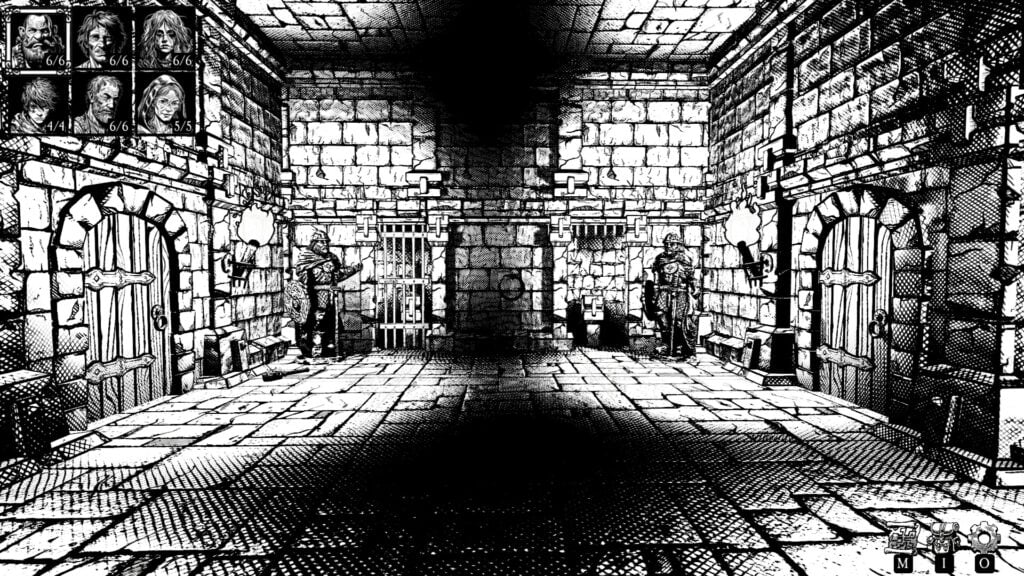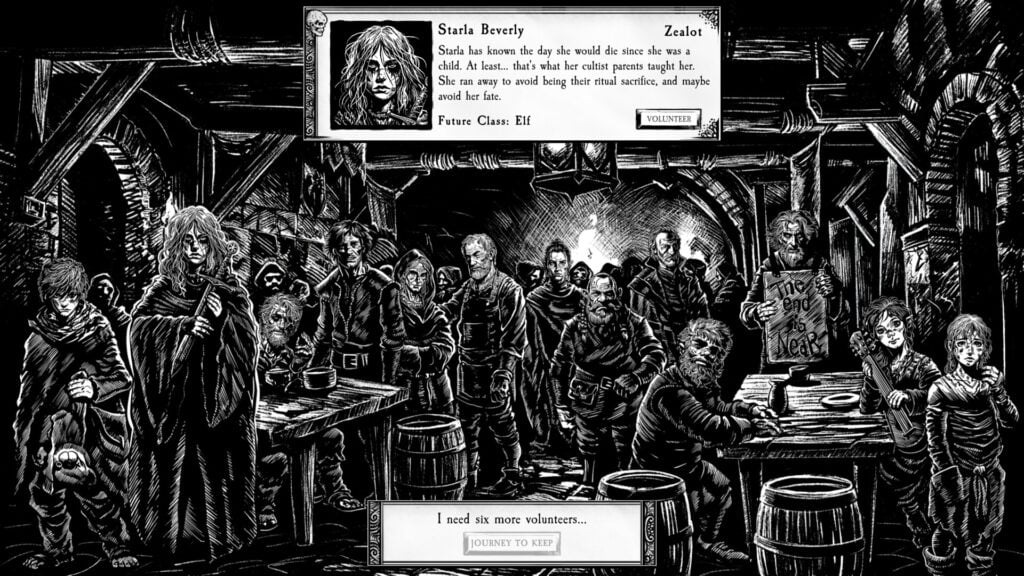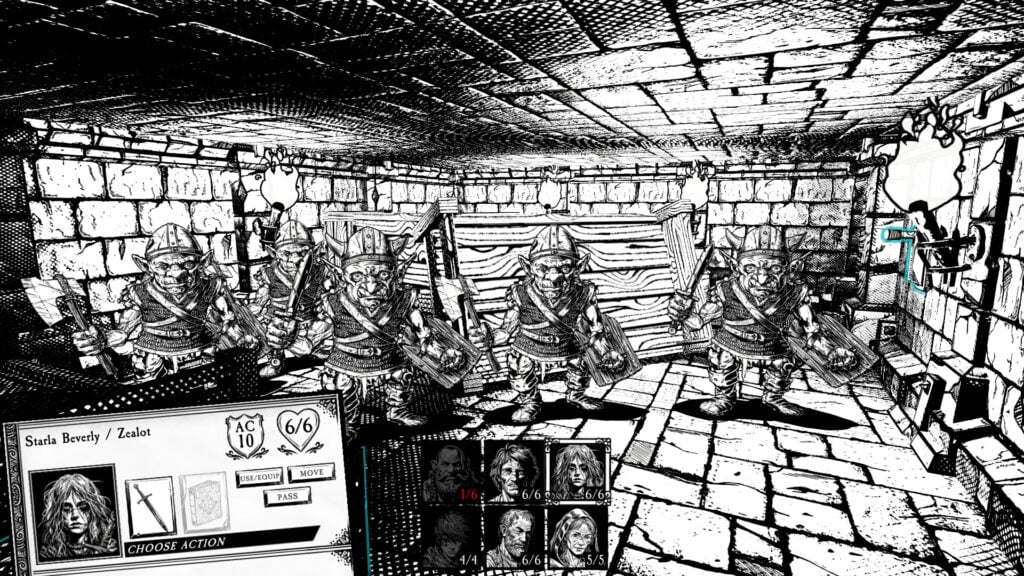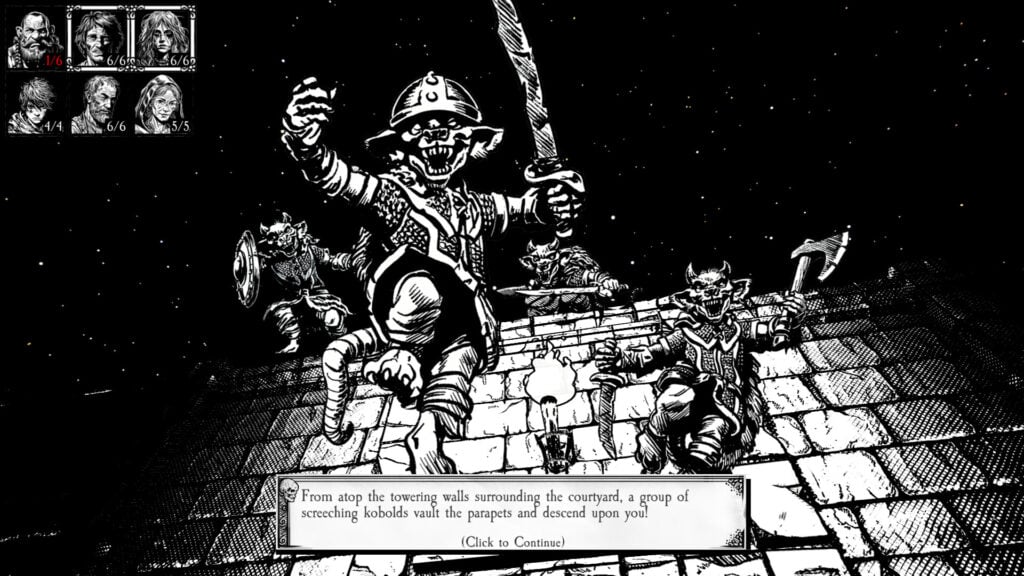Sometimes, certain games can capture and embody a feeling of nostalgia while modernizing it – and I’m not talking about remasters or remakes. I’m referring to games that feel familiar in concept, but provide a whole new experience that both nostalgic players and newcomers can enjoy. Developed by Talesworth Game Studio, The Secret of Weepstone is shaping up to be a prime example of this concept.
The Secret of Weepstone is a dungeon crawler inspired by ‘80s D&D, and its stunning hand-drawn black and white visuals somehow manage to mentally bring me back to a time when I never even existed. I was born in ‘95, but I can feel the devs’ nostalgia in everything from the art to the character select screen to the sense of danger the dungeon instills.
I got a chance to play a demo and talk to the founder of Talesworth Game Studio, Sean Gailey, at PAX West. I led a party through the Weepstone dungeon for about 20 minutes, then spoke to Gailey about old school D&D art, punishing campaigns, and his love of tabletop RPGs.

The demo starts with a short intro explaining the scenario and reason for the dungeon crawling. The Lord of Weepstone, Byron, has fallen ill, and it is believed that the source of his unholy visions and ailments can be found in Weepstone Keep.
I got to choose six townsfolk out of a lineup of 13, and send them off into the keep as members of my dungeon-crawling party. Each character had a backstory, a specialty, and a future class that they could access after leveling up. While there were 13 townspeople lined up to be chosen, only six were available for this demo.
Why Use Black and White?
The Secret of Weepstone immediately caught my eye with its art direction and style, even before I knew a single thing about its genre or gameplay. So, naturally, it was the first topic of discussion, which led to a trip down memory lane.
“My favorite art style has always been the late ‘70s, early ‘80s D&D art. Not just because it looked so nice, but there was an added challenge to that art. They could only work with black and white ink,” Gailey explained. “And so you couldn’t do grayscale, [and] you didn’t have pencil shading. I wanted to bring that to life in a video game. There’s so much great art in the D&D books and in the modules, but the player, a lot of times, never saw that art.”
The first notable moment where the art is on display is during character selection, which I mentioned earlier. The 13 townspeople are all lined up across the screen in a tavern, and each of them has a distinct look that quickly gives off a specific vibe or disposition. Their designs compelled me to read all 13 backgrounds/introductions, even though only six designated people could be chosen.
“We wanted to use a standard set of starting characters,” Gailey said. “They will give feedback during the game based on [their backgrounds].” For example, two of the townspeople used to work in Weepstone Keep, so while dungeon crawling, they have insights and dialogue that other characters don’t. And you can also find new party members inside the keep itself to bring the party up to a maximum of eight people.

Danger Awaits Inside the Keep…
I was met with a quick puzzle immediately upon entering Weepstone Keep, but once it was solved, I was free to explore however I wished. I roamed the halls, opened random doors, and even recruited a new party member who could offer more knowledge about the keep.
The keep’s ominous atmosphere had me playing cautiously. I found myself hesitating to open every door or attempt seemingly dangerous skill checks. But I soon ended up in combat after investigating a strange noise behind a closed door.
Several goblins popped out, and the game immediately had me roll for initiative. The party members are set up in rows that represent their distance from the enemies. There are three characters per row, and based on their equipped weapon, they either need to be close (sword, dagger, and short-range melee weapons) or can attack from a distance (bow, spear, and other medium to long-range weapons).
I had to roll on every attack and take into account my party members’ stats compared to the goblins’ AC (Armor Class), as you’d expect from a D&D-inspired game. I emerged victorious after a few lucky attack rolls, along with some help from tutorial hints.
“When you get into a combat [scenario], you notice the camera freezes and things come out. I wanted that to be like the images from the books come to life,” said Gailey as we discussed the presentation in combat encounters. “Really, this is a love letter to old-school Renaissance gaming, to basic and expert D&D… and all the other early tabletop role-playing games.”

…And Danger Leads to Death
I only realized that I was lucky in the first goblin encounter after going through subsequent combat scenarios against more goblins and a bug-like monster. Several party members had low health, and I couldn’t heal them all. The Secret of Weepstone isn’t forgiving in that way, but death is meant to be part of the experience through the Mortal Favor mechanic.
Each townsperson you recruit at the beginning of the game has a unique Mortal Favor buff that they grant to the rest of the party after dying. You may lose a party member, but when that happens, you can gain a strong permanent benefit.
“I wanted it to be almost inevitable that you would lose someone, so I could talk about the Mortal Favor mechanic,” said Gailey, laughing. “The concept of ‘Oh, I just walked into this, and I just died,’ won’t be a part of the design. There’s usually going to be clues either from what the dungeon master says, the narrator, or from something you can see visually that would hint that, okay, this is dangerous.”
Death can come swiftly in The Secret of Weepstone, but it never felt unfair. I lost two party members back-to-back in the same room because I ignored the narrator’s warnings and decided to roll the dice with my saving throws.
I entered a latrine in the keep and saw a shiny treasure inside an extremely filthy toilet. I snagged a new item, but at the cost of a whole human life because they got poisoned. Then, I looked inside another toilet, and the narrator mentioned that the water inside seemed to lead to somewhere unseen. I sent someone to jump inside, and they were never heard from again.
“I don’t want it to be where you’re so cautious that if someone dies, you reload,” Gailey said. “Right now, you reload when you die. So, the goal is to train the players that it’s okay to die and celebrate death. That’s the goal. The latrine death is meant to be funny, but also to teach the players that it’s okay if you die.”

I learned my lesson after the second death and was at least thankful for the Mortal Favor boon. Gailey mentions that the new party members you pick up inside the keep are meant to possibly replace lost members, or even be used for those riskier dice roll situations.
“Some of my favorite D&D stories are things like that,” Gailey said. “When people die, they’re some of my best stories from playing D&D. I knew it was gonna be a challenge, and from the beginning, we were like, ‘I don’t know if players will accept that.’ There needs to be benefits – permanent benefits – which isn’t normally part of D&D. But I needed to kind of overcompensate so that player death would be accepted and okay. And there’s gonna be a lot of people you meet along the way.”
My demo experience ended soon after losing those two party members, but it’s good to know that the goal is to have players meet several new potential traveling companions while exploring the keep. And I’m looking forward to the day I can get more hands-on time with the game in the future.
The Secret of Weepstone doesn’t currently have a release date, but at the end of our interview, Gailey said he’s hoping for a 2026 release on Steam after one more year of development.


